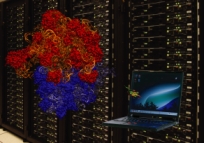
Back row: Profs. Alek Aksimentiev, Zaida Luthey-Schulten.
Front row: Profs. Emad Tajkhorshid, Laxmikant Kalé, Klaus Schulten.
|
Theoretical and Computational Biophysics Group
Beckman Institute, University of Illinois at Urbana-Champaign
71st Annual Meeting of the U of I Foundation
Invitation to Mini-symposium
"Computational Medicine"
(Note: on Sept. 15, 2006, TCBG faculty presented a mini-symposium to members of the U of I Foundation. Below are Professor Schulten's introductory comments for each segment of the symposium.)
Dear Ladies and Gentlemen:
I am Klaus Schulten, Professor of Physics at our University. Thank you very much for coming for the mini-symposium of the Beckman Institute Theoretical and Computational Biophysics group. This group is interdisciplinary with five faculty members who will each tell you a one minute story of great engineering and science at the University of Illinois, spending also a minute to introduce their field and giving you a minute to ask a question or two. Our faculty and students come from the physical, life, and engineering sciences.
|
|
Prof. Laxmikant Kalé, Computer Science:
Great Lakes Initiative in Petascale Computing
The group brings computer simulations to medicine. Like Boeing is simulating new generation air planes, we simulate the chemical, mechanical, and genetic factories of the cells in our body; these factories are responsible for our health. The computer is needed since the machines are too small to see in action, even for the most advanced microscopes today. These microscopes are actually billion dollar accelerators, like the advanced photon source at Argonne National labs near Chicago. The next generation computer microscope will be almost as expensive and my colleague Professor Kalé, from our Department of Computer Science, will tell you about University of Illinois' role in it.
|

|
|

|
Prof. Aleksei Aksimentiev, Physics:
Tomorrow's DNA Sequencing
Next will speak Professor Aksimentiev, from the Department of Physics, who collaborates closely with University of Illinois electrical engineers on the next generation of personalized medicine made possible through cheap and fast sequencing of a patient's genome. Between you and me, he is really in it for the money, for there is a $20 million prize waiting for those who succeed first.
|
|
Prof. Emad Tajkhorshid, Biochemistry:
Molecular Water Channels Keep You Healthy
Next will speak Professor Tajkhorshid, from the Department of Biochemistry, who collaborates closely with physiologists on a protein that filters every day a bathtub of water through our kidneys and keeps our brain afloat in a protective liquid. His work was mentioned in connection with the 2003 Nobel Prize showing his famous running water movie. As you will see for yourself, his work is very beautiful; he even won a highly regarded prize for scientific illustration.
|

|
|

|
Prof. Zaida Luthey-Schulten, Chemistry:
Scientific Basis of Biological Evolution
Next will speak Professor Luthey-Schulten, from the Department of Chemistry, who collaborates closely with our world-renowned Carl Woese on the origin of life and the history of evolution on Earth. Her work is revolutionizing biology and permits all of us a deep view back into where life came from. She will tell you of the slowest clock known to man, the only clock slow enough to time a billion years of evolution.
|
|
Prof. Klaus Schulten, Physics:
Viruses - Seeing the Enemy up Close
Next I will speak myself. I introduced myself already as a Professor of Physics. I collaborate with virologists to understand how viruses infect human cells, a subject of particular interest in regard to the present threat of the bird flu becoming a human pandemic. My students and I worked on simulating, for the first time, an entire life form, a small virus called STMV. Placing the virus in a cube of water we were able, with Professor Kalé's help, to "test drive" a brief time in the life of the virus in the computer. Even though brief, the simulation turned around our understanding of the virus life cycle. The virus, which looks much like a new soccer ball, is made of sixty pieces forming a spherical shell. When the virus approaches a cell, in this case in a plant, it needs to protect the capsid's content, the genes of the virus. But when it docks onto a cell, it needs to open and insert its genes into the cell. The mystery of the virus is its ability to protect its genes, but then quickly release them at the right moment. So one needs to understand how the shell is assembled and disassembled. The idea was that the shell is like a rigid house, letting the genes through the door. But the computation lead to a surprising discovery: the shell is more like my shirt, which has no shape until I put it on. So the genes of a virus come first, and they pull the virus shell around themselves. Today we can simulate entire small viruses, tomorrow we will simulate entire cells with Professor Kalé's new computer.
|

|
|